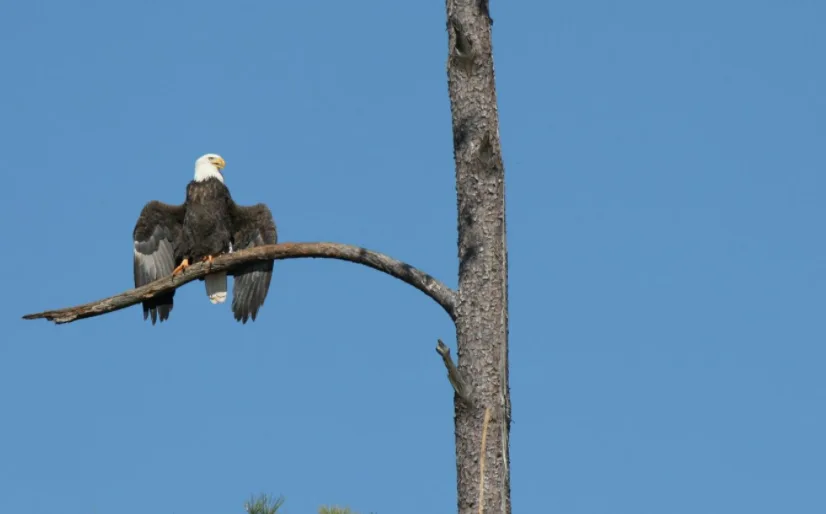
Cause of mysterious autumn bald eagle deaths pinpointed in new study
The cause of the mysterious deaths has been pinpointed, thanks to decades-long research.

A bald eagle's drooped wings show signs of brain infection caused by the bacteria Aetokthonos hydrillicola, which grows on the leaves of the invasive hydrilla plant in human-made lakes. Caption and photo credit: UGA.
In 1994, dozens of dead bald eagles were found near an Arkansas lake. Unfortunately, the heartbreaking discovery wasn't an isolated event, followed by the deaths of waterfowl, amphibians, and fish, typically in late fall and winter, and happening with regularity.
Researchers knew the deaths were occurring within reservoirs containing an excess of invasive aquatic weeds called hydrilla, which can cause birds to die within five days of their arrival. They also knew the animals were dying of a neurological disease called vacuolar myelinopathy. But the toxin that triggered the illness remained a mystery, prompting a decades-long, international study that led researchers towards pinpointing the source.
Now, in a new paper using data spanning nearly 30 years, an interdisciplinary research group from the University of Georgia alongside international collaborators has identified a new toxic blue-green algal (cyanobacteria) species that grows on hydrilla leaves.
CONFIRMING THE TOXIN'S STRUCTURE
The paper provides a new mapping of the bacteria' genome, allowing researchers to understand how it develops and survives in manmade lakes.
Susan Wilde, an associate professor of aquatic science at the Warnell School of Forestry and Natural Resources, and her team have been studying the cyanobacteria since the early 2000s, following bald eagle deaths in Georgia, South Carolina, and North Carolina.
Cultivating the bacteria in the lab yielded negative results, with tests saying they did not induce the disease.
Then Steffen Breinlinger, a doctoral student involved in the study, used a new imaging mass spectrometer to analyze the surface of the plant's leaf, one molecule at a time. Only then a new substance was discovered on leaves where cyanobacteria are present, and not in lab cultures.
It turns out the missing ingredient was bromide, present in all of the manmade lakes containing the hydrilla but not in lab-grown samples.
"The structure is really spectacular," Breinlinger said in a statement.
"We then added bromide to our lab cultures, and the cyanobacteria started producing the toxin."
Testing continued for almost a decade, with scientists finally confirming the molecule triggers the neurological disease.
The team calls the discovery aetokthonotoxin, or the "poison that kills the eagle."
DANGER TO HUMANS
The bacteria has been found in waterways across the U.S., prompting researchers to warn anyone who spends time in nature -- including hunters, fishers, and birdwatchers -- to avoid consuming infected animals and to watch for signs of neurological infection.
In animals, symptoms include erratic movement or convulsions, but while easier to observe in birds, beavers, and amphibians, Wilde says in a statement signs of the disease can be hard to spot in fish.
"I would avoid eating fish with lesions or some sort of deformities; we do see affected fish with slow swimming speeds, but anglers won't be able to see that," Wilde added.
"We want people to know the lakes where this disease has been documented and to use caution in consuming birds and fish from these lakes."
ABOUT HYDRILLA
Hydrilla has not been detected in Canada, according to the Government of Ontario. It is, however, present on every continent except Antarctica.
The aquatic plant is highly adaptable and fast-growing, climbing up to 2.5 centimetres per day. It may have originally come from warmer climates in Asia, while others believe it originates from Africa or Australia.
Hydrilla made its way into North America in the 1950s when it was brought to the U.S. for use in aquariums, spreading into ponds and lakes when people dumped their fish tanks out in public places. It has since spread throughout the country.











